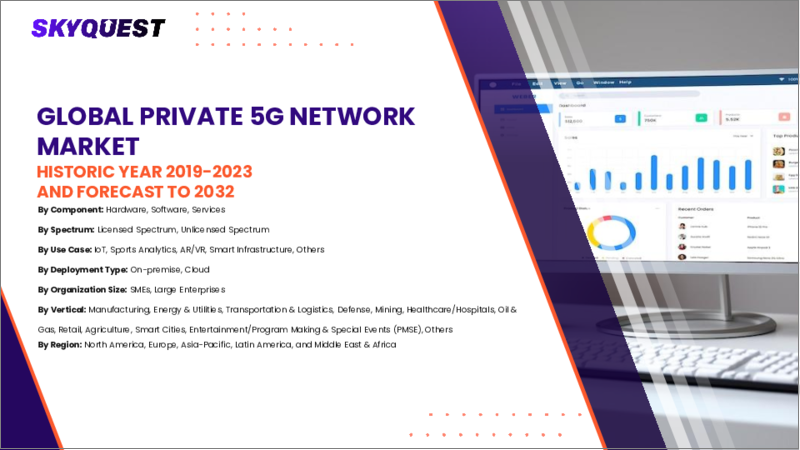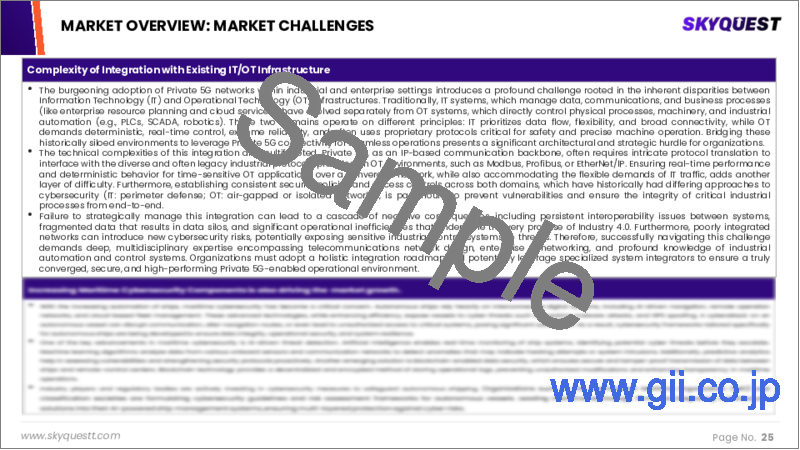|
|
市場調査レポート
商品コード
1724832
プライベート5Gネットワークの市場規模、シェア、成長分析、コンポーネント別、使用事例別、周波数帯域別、スペクトル別、組織規模別、展開タイプ別、地域別 - 産業予測 2025~2032年Private 5G Network Market Size, Share, and Growth Analysis, By Component (Hardware, Software), By Use Case (IoT, Sports Analytics), By Frequency Band, By Spectrum, By Organization Size, By Deployment Type, By Region - Industry Forecast 2025-2032 |
||||||
|
|||||||
| プライベート5Gネットワークの市場規模、シェア、成長分析、コンポーネント別、使用事例別、周波数帯域別、スペクトル別、組織規模別、展開タイプ別、地域別 - 産業予測 2025~2032年 |
|
出版日: 2025年05月07日
発行: SkyQuest
ページ情報: 英文 196 Pages
納期: 3~5営業日
|
全表示
- 概要
- 目次
プライベート5Gネットワークの世界市場規模は、2023年に20億米ドルと評価され、2024年の22億4,000万米ドルから2032年には55億9,000万米ドルに成長し、予測期間(2025-2032年)のCAGRは12.1%で成長する見通しです。
インダストリー4.0の登場により、効率的なマシンツーマシン(M2M)通信と相互接続デバイスの需要が大幅に高まっています。プライベート5Gネットワークは、スマート工場、自律運転、予知保全に必要な接続性を確立する上で不可欠であり、特に公共ネットワークへのアクセスが限られている遠隔地では重要です。これらのネットワークは、高速で信頼性の高い接続性を提供し、センサー、カメラ、デバイスからの継続的なデータフローを容易にします。低遅延機能はリアルタイム通信を可能にし、これは遠隔ロボット支援手術などのアプリケーションのためのヘルスケアなどの分野で不可欠です。さらに、プライベート5Gネットワークはセキュリティを強化し、ネットワークの混雑を緩和するため、ワイヤレスUHDカメラやクラウドベースのロボット工学のような先進技術を可能にする重要なインフラとして位置づけられ、さまざまな業界で広く採用されています。
目次
イントロダクション
- 調査の目的
- 調査範囲
- 定義
調査手法
- 情報調達
- 二次と一次データの方法
- 市場規模予測
- 市場の前提条件と制限
エグゼクティブサマリー
- 世界市場の見通し
- 供給と需要の動向分析
- セグメント別機会分析
市場力学と見通し
- 市場概要
- 市場規模
- 市場力学
- 促進要因と機会
- 抑制要因と課題
- ポーターの分析
主な市場の考察
- 重要成功要因
- 競合の程度
- 主な投資機会
- 市場エコシステム
- 市場の魅力指数(2024年)
- PESTEL分析
- マクロ経済指標
- バリューチェーン分析
- 価格分析
- 規制情勢
- ケーススタディ
- 技術分析
- 顧客と購買基準の分析
プライベート5Gネットワーク市場規模:コンポーネント別& CAGR(2025-2032)
- 市場概要
- ハードウェア
- 無線アクセスネットワーク
- コアネットワーク
- バックホールと輸送
- ソフトウェア
- サービス
- インストールと統合
- データサービス
- サポートとメンテナンス
プライベート5Gネットワーク市場規模:使用事例別& CAGR(2025-2032)
- 市場概要
- IoT
- スポーツ分析
- AR/VR
- スマートインフラ
- その他
プライベート5Gネットワーク市場規模:周波数帯域別& CAGR(2025-2032)
- 市場概要
- サブ6GHz
- ミリ波
プライベート5Gネットワーク市場規模:スペクトル別& CAGR(2025-2032)
- 市場概要
- ライセンス
- ライセンスなし/共有
プライベート5Gネットワーク市場規模:組織規模別& CAGR(2025-2032)
- 市場概要
- 中小企業
- 企業
プライベート5Gネットワーク市場規模:展開タイプ別& CAGR(2025-2032)
- 市場概要
- オンプレミス
- クラウド
プライベート5Gネットワーク市場規模:エンドユーザー別& CAGR(2025-2032)
- 市場概要
- BFSI
- 製造業
- エネルギー・公益事業
- 小売・Eコマース
- ヘルスケア
- インフラストラクチャー
- 運輸・物流
- 航空宇宙・防衛
- メディア・エンターテインメント
- IT・通信
プライベート5Gネットワーク市場規模:地域別& CAGR(2025-2032)
- 北米
- 米国
- カナダ
- 欧州
- ドイツ
- スペイン
- フランス
- 英国
- イタリア
- その他欧州地域
- アジア太平洋地域
- 中国
- インド
- 日本
- 韓国
- その他アジア太平洋地域
- ラテンアメリカ
- ブラジル
- その他ラテンアメリカ地域
- 中東・アフリカ
- GCC諸国
- 南アフリカ
- その他中東・アフリカ
競合情報
- 上位5社の比較
- 主要企業の市場ポジショニング(2024年)
- 主な市場企業が採用した戦略
- 最近の市場動向
- 企業の市場シェア分析(2024年)
- 主要企業の企業プロファイル
- 企業の詳細
- 製品ポートフォリオ分析
- 企業のセグメント別シェア分析
- 収益の前年比比較(2022-2024年)
主要企業プロファイル
- Huawei Technologies Co., Ltd.(China)
- Telefonaktiebolaget LM Ericsson(Sweden)
- Nokia Corporation(Finland)
- Samsung Electronics Co., Ltd.(South Korea)
- ZTE Corporation(China)
- NEC Corporation(Japan)
- Cisco Systems, Inc.(United States)
- Juniper Networks, Inc.(United States)
- Ciena Corporation(United States)
- Mavenir(United States)
- Altiostar(United States)
- Celona Inc.(United States)
- Airspan Networks(United States)
- CommScope(United States)
- Extreme Networks(United States)
- Comba Telecom Systems Holdings Ltd.(Hong Kong)
- Fujitsu(Japan)
- Dell Inc.(United States)
- VMware, Inc.(United States)
- Hewlett Packard Enterprise Development LP(United States)
結論と提言
Global Private 5G Network Market size was valued at USD 2.0 billion in 2023 and is poised to grow from USD 2.24 billion in 2024 to USD 5.59 billion by 2032, growing at a CAGR of 12.1% during the forecast period (2025-2032).
The advent of Industry 4.0 has significantly increased the demand for effective machine-to-machine (M2M) communication and interconnected devices. Private 5G networks are essential in establishing the connectivity required for smart factories, autonomous operations, and predictive maintenance, especially in remote areas with limited public network access. These networks provide high-speed, reliable connectivity, facilitating the continuous data flow from sensors, cameras, and devices. Their low-latency capabilities enable real-time communication, which is vital in sectors like healthcare for applications such as remote robotic-assisted surgeries. Additionally, private 5G networks enhance security and alleviate network congestion, positioning themselves as a vital infrastructure enabling advanced technologies like wireless UHD cameras and cloud-based robotics, driving widespread adoption across various industries.
Top-down and bottom-up approaches were used to estimate and validate the size of the Global Private 5G Network market and to estimate the size of various other dependent submarkets. The research methodology used to estimate the market size includes the following details: The key players in the market were identified through secondary research, and their market shares in the respective regions were determined through primary and secondary research. This entire procedure includes the study of the annual and financial reports of the top market players and extensive interviews for key insights from industry leaders such as CEOs, VPs, directors, and marketing executives. All percentage shares split, and breakdowns were determined using secondary sources and verified through Primary sources. All possible parameters that affect the markets covered in this research study have been accounted for, viewed in extensive detail, verified through primary research, and analyzed to get the final quantitative and qualitative data.
Global Private 5G Network Market Segments Analysis
Global Private 5G Network Market is segmented by Component, Use Case, Frequency Band, Spectrum, Organization Size, Deployment Type, End User and region. Based on Component, the market is segmented into Hardware, Software and Services. Based on Use Case, the market is segmented into IoT, Sports Analytics, AR/VR, Smart Infrastructure and Others. Based on Frequency Band, the market is segmented into Sub-6 GHz and mmWave. Based on Spectrum, the market is segmented into Licensed and Unlicensed/Shared. Based on Organization Size, the market is segmented into Small and medium-sized businesses and Enterprises. Based on Deployment Type, the market is segmented into On-premise and Cloud. Based on End User, the market is segmented into BFSI, Manufacturing, Energy & Utilities, Retail & E-commerce, Healthcare, Infrastructure, Transportation & Logistics, Aerospace & Defense, Media & Entertainment and IT & Telecommunications. Based on region, the market is segmented into North America, Europe, Asia Pacific, Latin America and Middle East & Africa.
Driver of the Global Private 5G Network Market
The Global Private 5G Network market is experiencing significant growth driven by the increasing demand for ultra-reliable, low-latency communication (URLLC) across various sectors, including manufacturing, healthcare, and logistics. These networks offer dedicated bandwidth and consistent connectivity, which are essential for real-time data transmission necessary for automated production lines, remote surgical procedures, and industrial robotics. Furthermore, the capability of private 5G networks to support mission-critical applications without disruptions has made them a highly appealing investment for businesses seeking to enhance operational efficiency and productivity. As a result, organizations are increasingly adopting private 5G solutions to meet their specific communication demands.
Restraints in the Global Private 5G Network Market
The establishment of a private 5G network presents notable financial challenges due to substantial costs associated with spectrum licensing, infrastructure deployment, and ongoing network maintenance. Businesses must allocate resources for 5G-compatible hardware, network management tools, and skilled personnel, which can be a daunting task for small and medium-sized enterprises (SMEs). Although the long-term advantages of adopting a private 5G network are evident, the significant initial investment required serves as a primary obstacle to broader acceptance and implementation, deterring many organizations from embracing this advanced technology.
Market Trends of the Global Private 5G Network Market
The Global Private 5G Network market is experiencing a significant shift towards AI-driven network optimization and automation, reflecting a broader technological trend. As enterprises seek enhanced operational efficiencies, AI technologies are being adopted for real-time network optimization, predictive maintenance, and automated resource allocation, which are essential in high-demand environments. The integration of AI in network slicing and traffic management empowers businesses to allocate bandwidth more effectively, ensuring seamless connectivity. As we move into 2024, the trend toward incorporating AI into network management solutions is expected to grow, allowing companies to enhance both performance and security, thus propelling the private 5G market forward.
Table of Contents
Introduction
- Objectives of the Study
- Scope of the Report
- Definitions
Research Methodology
- Information Procurement
- Secondary & Primary Data Methods
- Market Size Estimation
- Market Assumptions & Limitations
Executive Summary
- Global Market Outlook
- Supply & Demand Trend Analysis
- Segmental Opportunity Analysis
Market Dynamics & Outlook
- Market Overview
- Market Size
- Market Dynamics
- Drivers & Opportunities
- Restraints & Challenges
- Porters Analysis
- Competitive rivalry
- Threat of substitute
- Bargaining power of buyers
- Threat of new entrants
- Bargaining power of suppliers
Key Market Insights
- Key Success Factors
- Degree of Competition
- Top Investment Pockets
- Market Ecosystem
- Market Attractiveness Index, 2024
- PESTEL Analysis
- Macro-Economic Indicators
- Value Chain Analysis
- Pricing Analysis
- Regulatory Landscape
- Case Studies
- Technological Analysis
- Customer & Buying Criteria Analysis
Global Private 5G Network Market Size by Component & CAGR (2025-2032)
- Market Overview
- Hardware
- Radio Access Network
- Core Network
- Backhaul & Transport
- Software
- Services
- Installation & Integration
- Data Services
- Support & Maintenance
Global Private 5G Network Market Size by Use Case & CAGR (2025-2032)
- Market Overview
- IoT
- Sports Analytics
- AR/VR
- Smart Infrastructure
- Others
Global Private 5G Network Market Size by Frequency Band & CAGR (2025-2032)
- Market Overview
- Sub-6 GHz
- mmWave
Global Private 5G Network Market Size by Spectrum & CAGR (2025-2032)
- Market Overview
- Licensed
- Unlicensed/Shared
Global Private 5G Network Market Size by Organization Size & CAGR (2025-2032)
- Market Overview
- Small and medium-sized businesses
- Enterprises
Global Private 5G Network Market Size by Deployment Type & CAGR (2025-2032)
- Market Overview
- On-premise
- Cloud
Global Private 5G Network Market Size by End User & CAGR (2025-2032)
- Market Overview
- BFSI
- Manufacturing
- Energy & Utilities
- Retail & E-commerce
- Healthcare
- Infrastructure
- Transportation & Logistics
- Aerospace & Defense
- Media & Entertainment
- IT & Telecommunications
Global Private 5G Network Market Size & CAGR (2025-2032)
- North America (Component, Use Case, Frequency Band, Spectrum, Organization Size, Deployment Type, End User)
- US
- Canada
- Europe (Component, Use Case, Frequency Band, Spectrum, Organization Size, Deployment Type, End User)
- Germany
- Spain
- France
- UK
- Italy
- Rest of Europe
- Asia Pacific (Component, Use Case, Frequency Band, Spectrum, Organization Size, Deployment Type, End User)
- China
- India
- Japan
- South Korea
- Rest of Asia-Pacific
- Latin America (Component, Use Case, Frequency Band, Spectrum, Organization Size, Deployment Type, End User)
- Brazil
- Rest of Latin America
- Middle East & Africa (Component, Use Case, Frequency Band, Spectrum, Organization Size, Deployment Type, End User)
- GCC Countries
- South Africa
- Rest of Middle East & Africa
Competitive Intelligence
- Top 5 Player Comparison
- Market Positioning of Key Players, 2024
- Strategies Adopted by Key Market Players
- Recent Developments in the Market
- Company Market Share Analysis, 2024
- Company Profiles of All Key Players
- Company Details
- Product Portfolio Analysis
- Company's Segmental Share Analysis
- Revenue Y-O-Y Comparison (2022-2024)
Key Company Profiles
- Huawei Technologies Co., Ltd. (China)
- Company Overview
- Business Segment Overview
- Financial Updates
- Key Developments
- Telefonaktiebolaget LM Ericsson (Sweden)
- Company Overview
- Business Segment Overview
- Financial Updates
- Key Developments
- Nokia Corporation (Finland)
- Company Overview
- Business Segment Overview
- Financial Updates
- Key Developments
- Samsung Electronics Co., Ltd. (South Korea)
- Company Overview
- Business Segment Overview
- Financial Updates
- Key Developments
- ZTE Corporation (China)
- Company Overview
- Business Segment Overview
- Financial Updates
- Key Developments
- NEC Corporation (Japan)
- Company Overview
- Business Segment Overview
- Financial Updates
- Key Developments
- Cisco Systems, Inc. (United States)
- Company Overview
- Business Segment Overview
- Financial Updates
- Key Developments
- Juniper Networks, Inc. (United States)
- Company Overview
- Business Segment Overview
- Financial Updates
- Key Developments
- Ciena Corporation (United States)
- Company Overview
- Business Segment Overview
- Financial Updates
- Key Developments
- Mavenir (United States)
- Company Overview
- Business Segment Overview
- Financial Updates
- Key Developments
- Altiostar (United States)
- Company Overview
- Business Segment Overview
- Financial Updates
- Key Developments
- Celona Inc. (United States)
- Company Overview
- Business Segment Overview
- Financial Updates
- Key Developments
- Airspan Networks (United States)
- Company Overview
- Business Segment Overview
- Financial Updates
- Key Developments
- CommScope (United States)
- Company Overview
- Business Segment Overview
- Financial Updates
- Key Developments
- Extreme Networks (United States)
- Company Overview
- Business Segment Overview
- Financial Updates
- Key Developments
- Comba Telecom Systems Holdings Ltd. (Hong Kong)
- Company Overview
- Business Segment Overview
- Financial Updates
- Key Developments
- Fujitsu (Japan)
- Company Overview
- Business Segment Overview
- Financial Updates
- Key Developments
- Dell Inc. (United States)
- Company Overview
- Business Segment Overview
- Financial Updates
- Key Developments
- VMware, Inc. (United States)
- Company Overview
- Business Segment Overview
- Financial Updates
- Key Developments
- Hewlett Packard Enterprise Development LP (United States)
- Company Overview
- Business Segment Overview
- Financial Updates
- Key Developments






